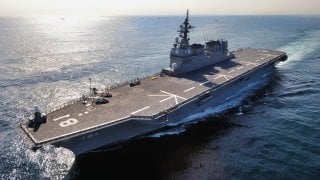Japan's Secret Aircraft Carriers are Right Out in the Open
While the Izumo ships initially only embarked helicopters, many observers noted they could accommodate larger airframes. This was later confirmed by officials in the Japanese military - the design was intended to handle the American-made F-35B, the VTOL variant of the Lightning II.
Ever since the U.S. began assuring its sovereignty at the conclusion of the Second World War, Japan has been limited in the size and scope of its military. Their very constitution limits possession of offensive weapons. One such weapon is the aircraft carrier. While most developed nations with naval presences and a vested interest in maritime security have aircraft carriers, Japan does not. There is a strong argument to be made, however, that Tokyo’s helicopter destroyers are functionally the same.
Hyuga-class helicopter destroyer
In the early 2000s, Japan’s Maritime Self-Defense Force developed the Hyuga-class helicopter destroyer. The Hyuga and her sister-ship Ise represented the largest ships built for the Japanese navy in over half a century when they were introduced.
These destroyers are well-equipped and possess similar specifications as the Italian Giuseppe Garibaldi and Spanish Principe de Asturias light aircraft carriers. Both warships are armed with a Phalanx close-in weapon system (CIWS) for self-defense and with a 16-cell VLS sporting the Evolved Sea Sparrow Missile surface-to-air missile. The two ships are primarily used in anti-submarine (ASW) activities.
While neither embarks fixed wing aircraft, their size and shape closely resemble light aircraft carriers.
Izumo-class destroyer:
The Izumo-class ships were planned following their Hyuga predecessors and are even larger in size, They too, were announced as being intended for anti-submarine operations with seven ASW helicopters and two search and rescue helicopters. They bear the same CIWS defense system as the Hyugas while also possessing a SeaRAM missile system.
While the Izumo ships initially only embarked helicopters, many observers noted they could accommodate larger airframes. This was later confirmed by officials in the Japanese military - the design was intended to handle the American-made F-35B, the VTOL variant of the Lightning II.
In 2018, the Japanese cabinet approved modifications to enable the Izumo and her sister ship Kaga to operate with the F-35. While some say this makes them capable of offensive operations thus violating the Japanese Constitution, the Japanese government maintains that they are strictly for defensive purposes.
Japan's Secret Aircraft Carriers?
Regardless of any statements, in 2021 a fixed-wing F-35B operated by the U.S. Marine Corps successfully took off from and landed on the JS Izumo. While she may still be called a destroyer or helicopter carrier to avoid running afoul of Japanese law, this successful test for all intents and purposes means she is now an aircraft carrier.
With modifications on the Izumo underway and those on the Kaga nearly complete, Japan now possesses its first aircraft carriers in decades.
The Japan Maritime Self-Defense Force is now capable of operating far from the air cover of the Japan Air Self-Defense Force, which provides a defensive depth previously missing. While the Izumo ships are a step in the right direction, these destroyers lack offensive capabilities and therefore cannot be adequately compared to other carriers including in the U.S., UK, China or Russia.
About the Author: Maya Carlin
Maya Carlin, National Security Writer with The National Interest, is an analyst with the Center for Security Policy and a former Anna Sobol Levy Fellow at IDC Herzliya in Israel. She has by-lines in many publications, including The National Interest, Jerusalem Post, and Times of Israel. You can follow her on Twitter: @MayaCarlin.
Image Credit: Creative Commons.


